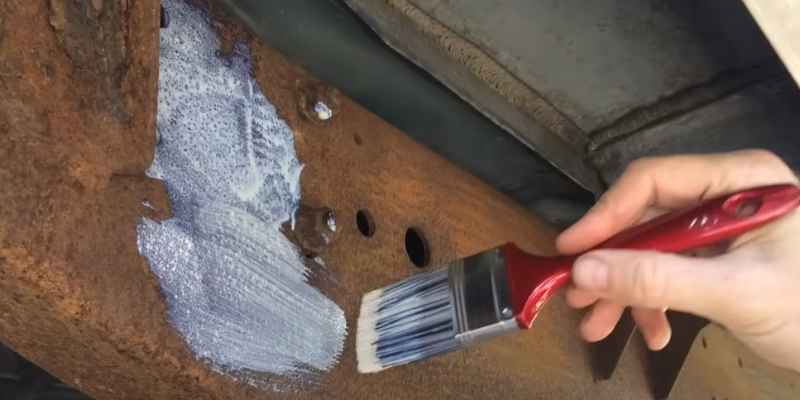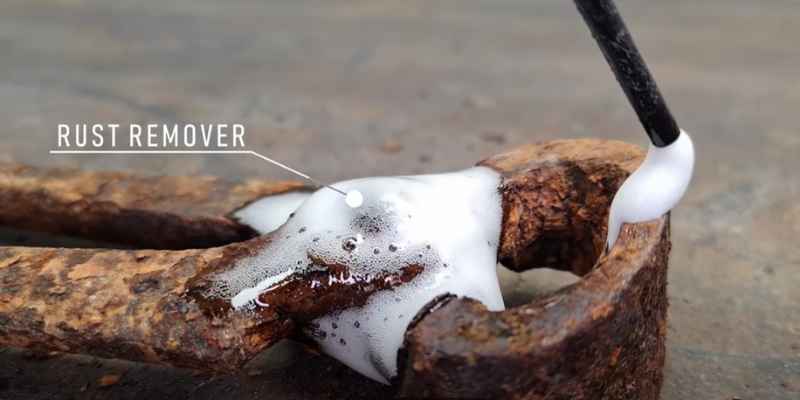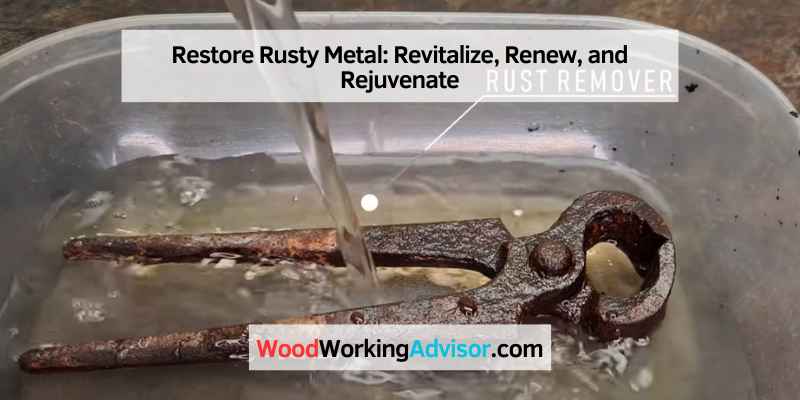To restore rusty metal, use a mixture of vinegar and baking soda for a simple solution. This natural method removes rust effectively.
Rusty metal can be an eyesore, but with the right techniques, you can restore it to its former glory. Whether it’s a vintage car, a garden tool, or a piece of furniture, dealing with rusty metal is a common challenge.
Fortunately, there are easy and cost-effective ways to tackle this issue without having to spend a fortune on expensive products or services. By using everyday household items like vinegar and baking soda, you can effectively remove rust and bring back the shine to your metal items. In this comprehensive guide, we’ll explore various methods to restore rusty metal and provide practical tips to help you achieve the best results.
Understanding Rust And Its Effects
Rust is a common issue that affects metal objects, causing them to deteriorate over time. Understanding rust and its effects is crucial in restoring rusty metal to its former glory.
What Causes Rust?
Rust is caused by the oxidation of iron or steel when exposed to moisture and oxygen.
Water acts as a catalyst, accelerating the oxidation process and leading to the formation of rust on the metal surface.
Why Does Rust Need To Be Restored?
Rust compromises the structural integrity of metal, making it weaker and more prone to damage.
Restoring rusty metal helps to prevent further deterioration and prolong the lifespan of the object.

Preparing The Rusty Metal
Rust can deteriorate the appearance and structural integrity of metal objects. Proper preparation of rusty metal is essential to ensure effective restoration.
Safety Measures
- Put on gloves and safety goggles to protect yourself from sharp edges and chemical cleaners.
- Work in a well-ventilated area to minimize exposure to fumes and chemicals.
Cleaning The Surface
Start by wiping the metal surface with a damp cloth to remove dust and dirt. This step helps the cleaning process be more effective.
Removing Loose Rust
- Use a wire brush or sandpaper to scrub the rusty areas until you’ve removed any loose rust flakes.
- Alternatively, you can apply a rust converter to chemically transform the rust into a stable compound.
Choosing The Right Restoration Method
When it comes to restoring rusty metal, choosing the right restoration method is crucial for achieving optimal results. The method you select will depend on various factors, including the severity of the rust, the type of metal, and your desired outcome. In this article, we will explore three effective options for restoring rusty metal: chemical rust converters, abrasive techniques, and painting and coating options. Let’s delve into each method to understand their benefits and considerations.
Chemical Rust Converters
Chemical rust converters are a popular choice for removing and converting rust on metal surfaces. These converters contain specialized chemicals that react with rust to create a stable compound that can be painted or coated. The process is simple – you apply the converter directly onto the rusted surface, allowing it to react and transform the rust into a black protective coating. It is important to note that while chemical rust converters are effective in stopping rust from spreading, they may not restore the metal’s original appearance.
Abrasive Techniques
Abrasive techniques involve physically removing rust from the metal surface using abrasive materials or tools. Popular options include sanding, wire brushing, or using sandblasting equipment. Sanding involves using sandpaper or an abrasive pad to manually rub away the rust, while wire brushing utilizes wire bristles attached to a handheld brush. Sandblasting, on the other hand, uses compressed air to propel abrasive particles at high speed onto the rusted metal, effectively removing the rust. Abrasive techniques are ideal for restoring metal to its original appearance, but they require more effort and can be time-consuming.
Painting And Coating Options
Painting and coating options are commonly used to restore rusty metal while providing long-lasting protection against future rusting. Before applying paint or a coating, it is essential to prepare the metal surface by removing any loose rust and applying a primer. Thereafter, you can choose from various coating options such as enamel paint, rust-inhibiting paint, or clear protective coatings. These coatings not only enhance the appearance of the metal but also create a barrier that prevents moisture and oxygen from reaching the surface, thereby reducing the risk of further rusting.
Each of these restoration methods offers unique benefits and considerations. While chemical rust converters are convenient for stopping rust, abrasive techniques provide a more effective way to restore metal to its original look. Painting and coating options, on the other hand, offer both restoration and long-term protection. Evaluate your rusted metal’s condition and your desired outcome to determine the most suitable restoration method for your needs.
Applying Rust Treatment
When it comes to dealing with rusty metal, applying rust treatment is essential to prevent further corrosion and restore the metal to its former glory. This process involves several steps to effectively remove rust and protect the metal from future oxidation. By applying chemical rust converters, using abrasive tools for rust removal, and applying primer and paint, you can effectively restore rusty metal to its original condition.
Applying Chemical Rust Converters
Chemical rust converters are specially formulated solutions that chemically react with rust, transforming it into a stable compound that can be painted over. When applying chemical rust converters, it’s important to follow the manufacturer’s instructions carefully. Start by cleaning the metal surface to remove any loose rust or debris. Then, apply the rust converter using a brush or spray applicator, ensuring even coverage over the entire rusted area. Allow the converter to dry fully before proceeding with the next steps.
Using Abrasive Tools For Rust Removal
Abrasive tools, such as wire brushes, sandpaper, or sandblasters, are effective for removing stubborn rust from metal surfaces. Gently scrub the rusted areas with the abrasive tool, being careful not to damage the metal underneath. Regularly clean and check the surface to monitor progress and prevent over-removal of metal. Ensure all rusted areas are thoroughly removed before proceeding to the next step.
Applying Primer And Paint
Once the rust has been treated and removed, it’s crucial to apply a protective primer and paint to the metal surface. Start by applying a rust-inhibiting primer to create a durable base for the paint. Allow the primer to dry completely before applying the chosen paint. Choose a paint that is specifically formulated for metal surfaces and provides long-lasting protection against corrosion. Apply multiple thin coats of paint, allowing each coat to dry before applying the next.
Preventing Future Rust
Preventing future rust is crucial to maintaining the longevity and appearance of metal surfaces. By implementing proper maintenance and protective measures, you can ensure that your metal remains in top condition for years to come. Here’s how you can prevent future rust:
Routine Inspection And Maintenance
Regularly inspect metal surfaces for signs of corrosion and address any issues promptly. Implementing a routine maintenance schedule can help identify and rectify areas prone to rust formation. It’s important to conduct visual inspections and clean the metal thoroughly to remove any contaminants. Regularly remove any accumulated dirt or debris to prevent the onset of rust.
Applying Protective Coatings
Applying protective coatings such as paint, varnish, or rust-inhibiting sealants can create a barrier against moisture and oxygen, preventing the metal from corroding. Ensure that the coating is applied evenly and thoroughly to provide maximum protection. Regularly inspect the coating for any signs of wear and reapply as necessary to maintain its effectiveness.
Storing Metal Properly
When storing metal items, ensure that they are kept in a dry and well-ventilated environment to prevent the buildup of moisture. Avoid stacking metal items directly on top of each other, as this can trap moisture and promote rust formation. Utilize moisture-absorbing materials such as silica gel or desiccants to maintain optimal storage conditions.

Alternative Methods And Diy Solutions
Explore alternative methods and DIY solutions to restore rusty metal surfaces efficiently and affordably. Discover practical tips and tricks to revitalize metal objects with household items, saving time and money in the process.
Rusty metal can be an eyesore, but there are alternative methods and DIY solutions that can help you restore its former glory. Instead of relying on commercial rust removers, which may contain harsh chemicals, you can opt for natural remedies that are not only effective but also environmentally friendly.
Natural Rust Removers
One of the easiest ways to remove rust from metal is by using natural ingredients that you can find in your kitchen pantry. These ingredients have properties that can dissolve rust and restore the metal to its original condition. Here are a few natural rust removers you can try:
- Vinegar: Soak the rusty metal in vinegar for a few hours or overnight. The acetic acid in vinegar helps break down the rust, making it easy to scrub off with a brush or sponge.
- Lemon juice: Squeeze fresh lemon juice onto the rusted area and let it sit for a few hours. The acidic properties of lemon juice will work to dissolve the rust.
- Baking soda: Make a thick paste by mixing baking soda with water. Apply the paste onto the rusted surface and let it sit for a few hours. The alkaline nature of baking soda helps neutralize the rust.
- Potatoes: Cut a potato in half and sprinkle salt on the cut side. Rub the potato on the rusted metal, applying pressure. The oxalic acid in potatoes reacts with the rust, loosening it from the surface.
Home Remedies For Rust Removal
Apart from natural rust removers, there are several home remedies that can be effective in removing rust from metal objects. These remedies involve using common household items that you may already have. Here are a few home remedies you can try:
- Cola: Pour cola onto the rusted area and let it sit for a few minutes. The phosphoric acid in cola helps dissolve the rust.
- Onion and salt: Cut an onion in half and sprinkle salt on the cut side. Rub the onion on the rusty surface, applying pressure. The acid in onions reacts with rust, making it easier to remove.
- Citric acid: Dissolve citric acid powder in water and soak the rusty object in the solution for a few hours. Citric acid is a mild acid that can effectively remove rust.
- Club soda: Pour club soda onto the rusted area and scrub with a brush or sponge. The carbonation in club soda helps loosen the rust.
Restoring rusty metal doesn’t have to be a complicated and expensive process. With these alternative methods and DIY solutions, you can remove rust using natural rust removers and common household items. Give these methods a try and see the transformation of your rusty metal objects. Remember to always take proper safety precautions, such as wearing gloves and goggles, when working with rust removers.
Frequently Asked Questions Of Restore Rusty Metal
How Can I Remove Rust From Metal Surfaces?
To remove rust from metal surfaces, start by scrubbing with a wire brush to remove loose rust. Then, apply a rust converter to neutralize the remaining rust. Finish with a coat of rust-inhibiting primer and paint to prevent further rusting.
What Are The Best Methods For Preventing Metal Rust?
To prevent metal rust, regularly clean and dry metal surfaces to remove moisture. Apply a rust-inhibiting primer and paint to create a protective barrier. Store metal items in a dry environment and use desiccants or rust-proofing sprays for added protection.
Can Vinegar Be Used To Remove Rust From Metal?
Yes, vinegar can be used to remove rust from metal. Soak the rusty item in white vinegar for several hours. Then, scrub the surface with a brush or crumpled aluminum foil to remove the loosened rust. Rinse and dry thoroughly after the rust is removed.
Is It Possible To Restore Severely Rusted Metal Items?
It is possible to restore severely rusted metal items with dedicated effort. Use rust removers, sandpaper, or wire brushes to remove rust. Apply rust converters and rust-inhibiting primers. However, extremely corroded items may require professional restoration or replacement.
Conclusion
To bring back the shine to your rusty metal, follow these simple techniques and rejuvenate your surfaces. By using household items like vinegar, baking soda, or lemon juice, you can easily remove rust and restore the metal’s original beauty. Remember to clean, sand, and apply a protective coating to prevent future rusting.
With these effective methods, you can save money and avoid the need for costly replacements. Give your metal the attention it deserves and enjoy its renewed appearance for years to come.


